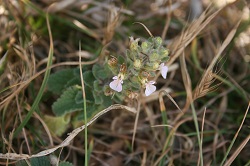
Teucrium bracteatum. Autor: J.L. Rendón Vega
LIFE action benefitting the species: C6.
Perennial and rhizomatous herb, with hairy, glandular stems with the ascending being the vegetative and the decumbent, the flowering plants. Leaves fixed to the soil at their base and arranged along the stem, petioled, triangular-ovate or ovate, with a rounded apex, cordiform and crenate, with crenas of almost 2 millimetres, with a reticulate, rough and hairy sheaf. Inflorescence of 6 to 12 centimetres, simple or branched, in a dense cluster in the shape of an ear, with whorls of 6 pedicellular flowers with bracteoles. Bilabiate, tubular- campanulate and gibbous calyx. Pseudo-bilabiate whitish, pinkish or yellowish corolla. It flowers and bears fruit from may to august.
Northwest Africa (Morocco and Algeria) and the southwest of the Iberian Peninsula (Cadiz and Malaga). In Andalusia, it has scattered hubs at the coastal front between Tarifa and Algeciras, in Cadiz, and a small hub in Casarabonela (Malaga). It occupies limestone scree fixed by the vegetation and clay embankments and slopes with nodes of bare sandstone or sandstone with thermophilous scrubland.
- SAC-SPAB Estrecho (ES0000337).
- SAC-SPAB Los Alcornocales (ES0000049).
- Risk of fires.
- Performing fire defence measures (creating and cleaning firebreaks).
- Trampling caused by livestock.
- Transformation of the land due to the installation of wind turbines.
- Andalusian Catalogue of Wild Species under Protection (Decree 23/2012), with the category “Vulnerable”.
In situ conservation:
- Prospecting of favourable environments and the monitoring of known populations.
Ex situ conservation:
- Storage of seeds in the Plant Seed Bank of Andalusia.
- Establishing of the Propagation Protocol in the Plant Propagation Laboratory and cultivation in the Andalusian Network of Botanic Gardens and Mycology in Natural Spaces.
- Preparing of forestry guidelines.












































